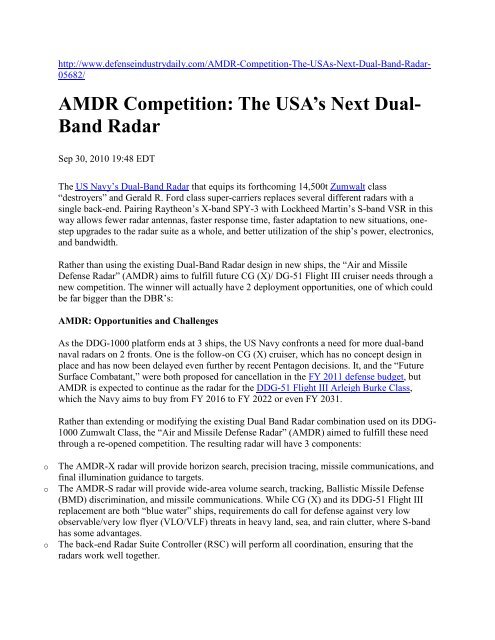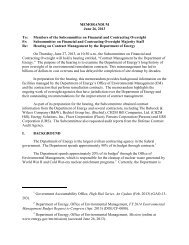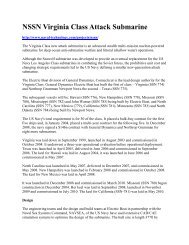AMDR Competition: The USA's Next Dual- Band Radar
AMDR Competition: The USA's Next Dual- Band Radar
AMDR Competition: The USA's Next Dual- Band Radar
You also want an ePaper? Increase the reach of your titles
YUMPU automatically turns print PDFs into web optimized ePapers that Google loves.
http://www.defenseindustrydaily.com/<strong>AMDR</strong>-<strong>Competition</strong>-<strong>The</strong>-USAs-<strong>Next</strong>-<strong>Dual</strong>-<strong>Band</strong>-<strong>Radar</strong>-<br />
05682/<br />
<strong>AMDR</strong> <strong>Competition</strong>: <strong>The</strong> USA’s <strong>Next</strong> <strong>Dual</strong>-<br />
<strong>Band</strong> <strong>Radar</strong><br />
Sep 30, 2010 19:48 EDT<br />
<strong>The</strong> US Navy’s <strong>Dual</strong>-<strong>Band</strong> <strong>Radar</strong> that equips its forthcoming 14,500t Zumwalt class<br />
“destroyers” and Gerald R. Ford class super-carriers replaces several different radars with a<br />
single back-end. Pairing Raytheon’s X-band SPY-3 with Lockheed Martin’s S-band VSR in this<br />
way allows fewer radar antennas, faster response time, faster adaptation to new situations, onestep<br />
upgrades to the radar suite as a whole, and better utilization of the ship’s power, electronics,<br />
and bandwidth.<br />
Rather than using the existing <strong>Dual</strong>-<strong>Band</strong> <strong>Radar</strong> design in new ships, the “Air and Missile<br />
Defense <strong>Radar</strong>” (<strong>AMDR</strong>) aims to fulfill future CG (X)/ DG-51 Flight III cruiser needs through a<br />
new competition. <strong>The</strong> winner will actually have 2 deployment opportunities, one of which could<br />
be far bigger than the DBR’s:<br />
<strong>AMDR</strong>: Opportunities and Challenges<br />
As the DDG-1000 platform ends at 3 ships, the US Navy confronts a need for more dual-band<br />
naval radars on 2 fronts. One is the follow-on CG (X) cruiser, which has no concept design in<br />
place and has now been delayed even further by recent Pentagon decisions. It, and the “Future<br />
Surface Combatant,” were both proposed for cancellation in the FY 2011 defense budget, but<br />
<strong>AMDR</strong> is expected to continue as the radar for the DDG-51 Flight III Arleigh Burke Class,<br />
which the Navy aims to buy from FY 2016 to FY 2022 or even FY 2031.<br />
Rather than extending or modifying the existing <strong>Dual</strong> <strong>Band</strong> <strong>Radar</strong> combination used on its DDG-<br />
1000 Zumwalt Class, the “Air and Missile Defense <strong>Radar</strong>” (<strong>AMDR</strong>) aimed to fulfill these need<br />
through a re-opened competition. <strong>The</strong> resulting radar will have 3 components:<br />
o<br />
o<br />
o<br />
<strong>The</strong> <strong>AMDR</strong>-X radar will provide horizon search, precision tracing, missile communications, and<br />
final illumination guidance to targets.<br />
<strong>The</strong> <strong>AMDR</strong>-S radar will provide wide-area volume search, tracking, Ballistic Missile Defense<br />
(BMD) discrimination, and missile communications. While CG (X) and its DDG-51 Flight III<br />
replacement are both “blue water” ships, requirements do call for defense against very low<br />
observable/very low flyer (VLO/VLF) threats in heavy land, sea, and rain clutter, where S-band<br />
has some advantages.<br />
<strong>The</strong> back-end <strong>Radar</strong> Suite Controller (RSC) will perform all coordination, ensuring that the<br />
radars work well together.
<strong>The</strong> contractors are designing radar systems with hardware and software modularity, future<br />
technology, insertion, and open architectures. <strong>The</strong> lack of a CG (X) design forced some<br />
flexibility all by itself, and the initial specification added that it’s “designed to be scalable to<br />
accommodate current and future mission requirements for multiple platforms.” With the shift to<br />
DDG-51 Flight III ships as the focus for both <strong>AMDR</strong> and the future US Navy, that specification<br />
becomes especially important.<br />
That requirement for adjustable size is the key to <strong>AMDR</strong>’s larger opportunity. If the adjustments<br />
can be taken far enough, it could give the Navy an opportunity to add or retrofit <strong>AMDR</strong> to some<br />
of its 60+ serving Arleigh Burke Class ships, DDG-1000 Zumwalt Class destroyers, or later<br />
carriers of the CVN-78 Gerald R. Ford Class.<br />
<strong>The</strong> bad news is that any retrofit, or even installation in new “DDG-51 Flight III” variants, will<br />
be more complicated than it appears.<br />
<strong>The</strong> visible face of a naval radar is only the tip of the iceberg. Most of its weight and space<br />
comes from its need for 2 things: power, and cooling. More powerful radars usually need more<br />
power to drive them, which can tax the limited 7.5 MW capacity an older ship like the DDG-51<br />
Flight I/II/IIAs. More power also means more cooling much of the time. Power storage, power<br />
conversion, and cooling require weight and space. All of which are usually in short supply on a<br />
warship. Even if that space exists, the additional equipment and antennas must be installed<br />
without unduly affecting the ship’s balance and center of gravity, and hence its seakeeping<br />
abilities.<br />
In 2009, the US Congressional Research Services’ “Navy DDG-1000 and DDG-51 Destroyer<br />
Programs: Background, Oversight Issues, and Options for Congress” report update (#RL32109)<br />
explained the potential impact:<br />
“Multiple industry sources have briefed CRS on their proposals for modifying the DDG-51<br />
design to include an active-array radar with greater capability than the SPY-1. If the DDG-51<br />
hull is not lengthened, then modifying the DDG-51 design to include an improved radar would<br />
require removing the 5-inch gun to make space and weight available for additional equipment<br />
needed to support operations with the improved radar. Lengthening the hull might provide<br />
enough additional space and weight capacity to permit the 5-inch gun to be retained.75<br />
Supporting equipment to be installed would include an additional electrical generator and<br />
additional cooling equipment.76 <strong>The</strong> best location for the generator might be in one of the ship’s<br />
two helicopter hangar spots, which would reduce the ship’s helicopter hangar capacity from two<br />
helicopters to one.”<br />
An October 2008 report from the right-wing Heritage Foundation draws on other sources to note<br />
that weight shifts can also create issues:<br />
”...SPY-1E [active array] radar could affect the stability of the upgraded Arleigh Burkes<br />
because the radar’s phased-array panels weigh more than the panels of the earlier SPY-1 radar,<br />
which it will replace. While the SPY-1E’s weight is concentrated more in the panels, freeing<br />
more space below deck,[78] this greater weight would be added to the ship’s superstructure.
Combined with the DDG-51’s relatively narrow hull width and short length, this could cause<br />
stability problems, particularly when sailing in rough weather.”<br />
Obviously, those kinds of trades are less than ideal, but they may be necessary. Whether, how<br />
many, and which trades end being necessary, may well depend on which contender’s design is<br />
chosen for <strong>AMDR</strong>.<br />
<strong>AMDR</strong>: <strong>The</strong> Contenders<br />
Lockheed Martin steps into the competition with several strengths to draw on. <strong>The</strong>ir AN/SPY-1<br />
S-band radar is the main radar used by the US Navy’s current high-end ships, the DDG-51<br />
Arleigh Burke class destroyers and CG-47 Ticonderoga class cruisers. Lockheed Martin also<br />
makes the AEGIS combat systems that equips these ships, and supplies the advanced VSR S-<br />
band radar used in the new <strong>Dual</strong> <strong>Band</strong> <strong>Radar</strong> installations on board Zumwalt and Ford class<br />
ships. This strong S-band experience, and status as the supplier of the combat system that any<br />
DDG-51 fitting would have to integrate with, gives them leverage at multiple points.<br />
Nor are they devoid of X-band or ballistic missile defense experience. <strong>The</strong>ir L-<strong>Band</strong> AN/TPS-59<br />
long range radar has been used in missile intercept tests, and is the only long range 3D <strong>Radar</strong> in<br />
the Marine Air-Ground Task Force. It’s related to the AN/TPS-117, which is in widespread<br />
service with over 16 countries. <strong>The</strong> Patriot missile’s successor MEADS system’s MFCR radar<br />
will integrate an active array dual-band set of X-band and UHF modules via a common processor<br />
for data and signal processing.<br />
Raytheon goes into <strong>AMDR</strong> with experience developing the existing <strong>Dual</strong>-<strong>Band</strong> <strong>Radar</strong>’s <strong>Radar</strong><br />
Suite Controller and SPY-3 X-band radar, along with the dual X/S band system that will equip<br />
the Cobra Judy (USNS Observation Island) Replacement vessel used to track missile launches<br />
and tests around the world. Phased array radars for wide-area air and ballistic missile defense are<br />
another strong point. Raytheon builds the AN/TPY-2 X-band radar used by the land-based<br />
THAAD missile system, the 280 foot high X-band array on the floating SBX missile defense<br />
radar, and the large land-based ballistic missile Upgraded Early Warning Systems like the<br />
AN/FPS-108 Cobra Dane and AN/FPS-115 PAVE PAWS. On the S-band side, the firm builds<br />
the S-band transmitters for Lockheed’s SPY-1 radar. Unsurprisingly, Raytheon personnel who<br />
talked to us said that:<br />
”... leveraging concepts, hardware, algorithms and software from our family of radars provides<br />
a level of effectiveness, reliability and affordability to our proposed <strong>AMDR</strong> solution…. <strong>The</strong><br />
challenge for all the competitors will be to deliver a modular design. <strong>The</strong> requirements demand<br />
that the design be scalable without significant redesign…. A high power active radar system<br />
requires significant space not only for the arrays themselves but also for the power and cooling<br />
equipment needed to support its operation. Finding space for additional generators and HVAC<br />
plants can be quite challenging for a backfit application. That is why power efficiency is a<br />
premium for these systems.”
Northrop Grumman was a less obvious contender, despite its enviable record making advanced<br />
AESA and phased array radars for use on aircraft of all types and sizes, and land-based systems<br />
like the US Marines’ Ground/Air Task Oriented <strong>Radar</strong> (G/ATOR).<br />
In subsequent discussions, he stressed that Northrop Grumman has shipboard radar experience,<br />
too. <strong>The</strong>y’re the prime contractor for the AN/SPQ-9B track-while-scan X-band radar, the SPS-74<br />
used to detect submarine periscopes, and navigation radars. On a less visible note, the firm has<br />
been working under several CRAD programs from 2005 to the present, targeted at technology<br />
demonstrations, system risk reduction, and advanced integration techniques for advanced S-band<br />
shipboard radars. <strong>The</strong>y also have a partnership with Australia’s CEA Technologies, which is<br />
developing an advanced X-band (CEAMOUNT) and S-band (CEAFAR) radar set for Australia’s<br />
ANZAC class frigate upgrade.<br />
What does this team see as important<br />
“<strong>The</strong> ability to scale up to a potential future cruiser or down to a DDG-51 variant is<br />
fundamental to the Northrop Grumman radar architecture. Size, weight and power (SWaP) of<br />
the radar system are the key drivers…. Minimizing the radar impact is key to an affordable<br />
surface combatant solution. We are focused on not just the radar technology, but to minimize the<br />
ship impact while allowing for scalable growth in the future. We are working closely with<br />
various elements in the Navy to address the ship impact of large AESA radars on the entire<br />
ship.”<br />
<strong>AMDR</strong>: Contracts and Key Events<br />
June 7/11: Raytheon announces that it has conducted a system requirements review (SRR) for<br />
<strong>AMDR</strong> Phase II beginning May 17/11. Notably, their release does not describe it as successful,<br />
offering only the less categorical claim that the “Navy’s feedback throughout the review was<br />
favorable,” and pointing out that the firm “matured its design ahead of schedule, surpassing<br />
customer expectations.”<br />
Raytheon is currently developing a technology demonstrator for <strong>AMDR</strong>’s S-band radar and radar<br />
suite controller, and the firm demonstrated hardware from that pilot array during the review. <strong>The</strong><br />
SRR also included Raytheon’s understanding of <strong>AMDR</strong>’s requirements, how its design and<br />
architecture meets those requirements, and Raytheon’s its analysis of those requirements,<br />
including cost and performance trade studies. A System Functional Review will be held later in<br />
2011.<br />
May 19/11: Raytheon announces that it has produced the first group of S-band transmit/receive<br />
(T/R) modules for the U.S. Navy’s <strong>AMDR</strong> program.<br />
Sept 30/10: US Naval Sea Systems Command in Washington Navy Yard, DC solicits bids via<br />
the Federal Business Opportunities website, receives 3 offers, and issues 3 technology<br />
development contracts for the <strong>AMDR</strong> S-band radar and its radar suite controller (RSC). <strong>AMDR</strong>-<br />
S will provide volume search, tracking, ballistic missile defense discrimination and missile<br />
communications. <strong>The</strong> RSC will perform all coordination actions to ensure that both radars work
together. This approach dovetails with the Pentagon’s focus on competitive prototypes, as a way<br />
of reducing long-term risks of failed development and cost overruns.<br />
Raytheon Integrated Defense Systems in Sudbury, MA received a $112.3 million fixed-price<br />
incentive (firm target) contract. Work will be performed in Sudbury, MA (81%), Fairfax, VA<br />
(18.3%), and New York, NY (0.7%), and is expected to be complete by September 2012<br />
(N00024-10-C-5340). See also Raytheon.<br />
Lockheed Martin Mission Systems and Sensors in Moorestown, NJ receives a $119.2 million<br />
fixed-price incentive (firm target) contract. Work will be performed in Moorestown, NJ (86.2%);<br />
Clearwater, FL (5.5%); Fairfax, VA (3.5%); New Brighton, MN (2.5%); Clearfield, UT (1.3%);<br />
and Huntsville, AL (1%), and is expected to be complete by September 2012 (N00024-10-C-<br />
5358). See also Lockheed Martin.<br />
Northrop Grumman Electronic Systems in Linthicum Heights, MD receives a $120 million<br />
fixed-price incentive (firm target) contract. This contract is incrementally funded, with $38.4<br />
million placed on the contract at the time of award. Work will be performed in Linthicum<br />
Heights, MD (99.4%), and Arvonia, VA (0.6%), and is expected to be complete by September<br />
2012 (N00024-10-C-5359). See also Northrop Grumman.<br />
Aug 10/10: An opinion from the Information Dissemination article Happy Thoughts and DDG-<br />
1000:<br />
“I love Chris, and I don’t think anyone in the Navy deserved their star more than Jim Syring…<br />
but this Navy Times article is just a bit too much happy half-the-story for me. Here is how half<br />
the story gets told…. <strong>The</strong> real reason the Navy is dropping the VSR on DDG-1000 is because the<br />
Navy intends to put… <strong>AMDR</strong> on the DDG-1000… because the timeline works out. <strong>The</strong> thing is<br />
the Navy can’t actually say this because there is no official <strong>AMDR</strong> program yet and the DDG-<br />
1000 isn’t supposed to be a ballistic missile defense ship – remember This story in Navy Times<br />
is what it is because when it comes to US Navy shipbuilding, the Navy under CNO Roughead is<br />
never completely honest with the American people about what the Navy is doing. Sorry if the<br />
truth hurts.”<br />
June 2/10: As expected, the Pentagon this week certifies that the DDG-1000 destroyer program<br />
is vital to national security, and must not be terminated, despite R&D loaded per-ship cost<br />
increases that put it over Nunn-McCurdy’s legislated limit. <strong>The</strong>re will be at least one important<br />
change, however: the S-band SPY-4 Volume Search <strong>Radar</strong> will be deleted from the DDG-1000’s<br />
DBR.<br />
Performance has met expectations, but cost increases reportedly forced the Navy into a<br />
cost/benefot decision. <strong>The</strong> Navy would not release numbers, but reports indicate possible savings<br />
of $100-200 million for each of the planned 3 ships. <strong>The</strong> X-band SPY-3 has reportedly exceeded<br />
technical expectations, and will receive upgrades to give it better volume search capability. <strong>The</strong><br />
move will save weight and space by removing SPY-4 aperture, power, and cooling systems, and<br />
may create an opportunity for Raytheon’s SPY-3 to be upgraded for ballistic missile defense – or<br />
replaced by the winner of the BMD-capable <strong>AMDR</strong> dual-band radar competition.
<strong>The</strong> full DBR will be retained on the USS Gerald R. Ford [CVN 78] aircraft carrier, as the SPY-<br />
4 replaces 2 air search radars and will be the primary air traffic control radar. No decision has<br />
been made for CVN 79 onward, however, and <strong>AMDR</strong>’s potential scalability may make it<br />
attractive there as well. Gannett’s Navy Times | US DoD.<br />
Feb 26/10: <strong>The</strong> US Congressional Research Service lays out what remains of <strong>AMDR</strong>’s<br />
opportunity, in an updated report. From “Navy DDG-51 and DDG-1000 Destroyer Programs:<br />
Background and Issues for Congress” :<br />
“<strong>The</strong> Navy’s FY2011 budget submission calls for procuring two DDG-51s in FY2011 and six<br />
more in FY2012-FY2015. <strong>The</strong> two DDG-51s that the Navy wants to procure in FY2011 received<br />
$577.2 million in FY2010 advance procurement funding. <strong>The</strong> Navy’s proposed FY2011 budget<br />
requests another $2,922.2 million in procurement funding for the two ships, so as to complete<br />
their estimated combined procurement cost of $3,499.2 million. <strong>The</strong> Navy’s proposed FY2011<br />
budget also requests $48.0 million in advance procurement funding for the one DDG-51 that the<br />
Navy wants to procure in FY2012, and $186.3 million in procurement funding for DDG-1000<br />
program-completion costs. <strong>The</strong> Navy’s FY2011 budget also proposes terminating the Navy’s<br />
planned CG (X) cruiser program as unaffordable. Rather than starting to procure CG (X)s<br />
around FY2017, as the Navy had previously envisaged, the Navy is proposing to build an<br />
improved version of the DDG-51, called the Flight III version, starting in FY2016. Navy plans<br />
thus call for procuring the current version of the DDG-51, called the Flight IIA version, in<br />
FY2010-FY2015, followed by procurement of Flight III DDG-51s starting in FY2016. Navy<br />
plans appear to call for procuring Flight III DDG- 51s through at least FY2022, and perhaps<br />
until FY2031. Flight III DDG-51s are to carry a smaller version of the new Air and Missile<br />
Defense <strong>Radar</strong> (<strong>AMDR</strong>) that was to be carried by the CG (X). <strong>The</strong> Navy’s proposed FY2011<br />
budget requests $228.4 million in research and development funding for the <strong>AMDR</strong>. Detailed<br />
design work on the Flight III DDG-51 reportedly is to begin in FY2012 or FY2013. Issues for<br />
Congress for FY2011 include the following:”<br />
June 26/09: <strong>The</strong> Naval Sea Systems Command in Washington, DC issues 3 firm fixed-price<br />
contracts, covering initial concept studies for the (<strong>AMDR</strong>) S-band and <strong>Radar</strong> Suite Controller<br />
(RSC) only. Deliverables will include the S-band and radar suite controller conceptual design,<br />
systems engineering studies and analyses, and a technology development plan. This contract was<br />
competitively procured via the Federal Business Opportunities and Navy Electronic Commerce<br />
Online websites, with 3 offers received.<br />
Northrop Grumman receives a $10 million contract. Work will be performed in Linthicum<br />
Heights, MD, and is expected to be complete by December 2009 (N00024-09-C-5398). See also<br />
NGC’s July 28/09 release.<br />
Lockheed Martin Maritime Systems and Sensors in Moorestown, NJ, receives a $10 million<br />
contract. Work will be performed in Moorestown, NJ, and is expected to be complete by<br />
December 2009 (N00024-09-C-5312). See also Lockheed Martin’s July 14/09 release.<br />
Raytheon Integrated Defense Systems in Sudbury, MA receives a $9.9 million contract. Work<br />
will be performed in Sudbury, MA (94%); Fairfax, VA (4%); Bath, ME (3%); Andover, MA
(3%); Tewksbury, MA (3%); and East Syracuse, NY (2%), and is expected to be complete by<br />
December 2009 (N00024-09-C-5313). See also Raytheon’s Aug 3/09 release.<br />
Additional Readings<br />
o<br />
o<br />
o<br />
o<br />
o<br />
US Congressional Research Services’ “Navy DDG-1000 and DDG-51 Destroyer Programs:<br />
Background, Oversight Issues, and Options for Congress. Also explains the Future Surface<br />
Combatant option.<br />
GlobalSecurity.org – Solid State SPY <strong>Radar</strong>/ Air and Missile Defense <strong>Radar</strong> (<strong>AMDR</strong>)/ Air &<br />
Missile Defense <strong>Radar</strong> (A&MD <strong>Radar</strong>)/ <strong>Next</strong>-Generation Maritime Air & Missile Defense/<br />
Multi-Function Advanced Active Phased-Array <strong>Radar</strong><br />
Military & Aerospace Electronics (June 29/09) – <strong>Next</strong>-generation missile defense radar systems<br />
for Navy warships is goal of new study contracts<br />
Defense News (Feb 2/09) – New Destroyer Emerges in U.S. Plans: Options Mulled As DDG<br />
1000 Hits $6 Billion. Includes <strong>AMDR</strong> coverage.<br />
DID Spotlight – <strong>The</strong> US Navy’s <strong>Dual</strong> <strong>Band</strong> <strong>Radar</strong>s. Covers the SPY-3/VSR combination aboard<br />
the new DDG-1000 Zumwalt class destroyers and CVN-78 Gerald R. Ford class aircraft carriers.






